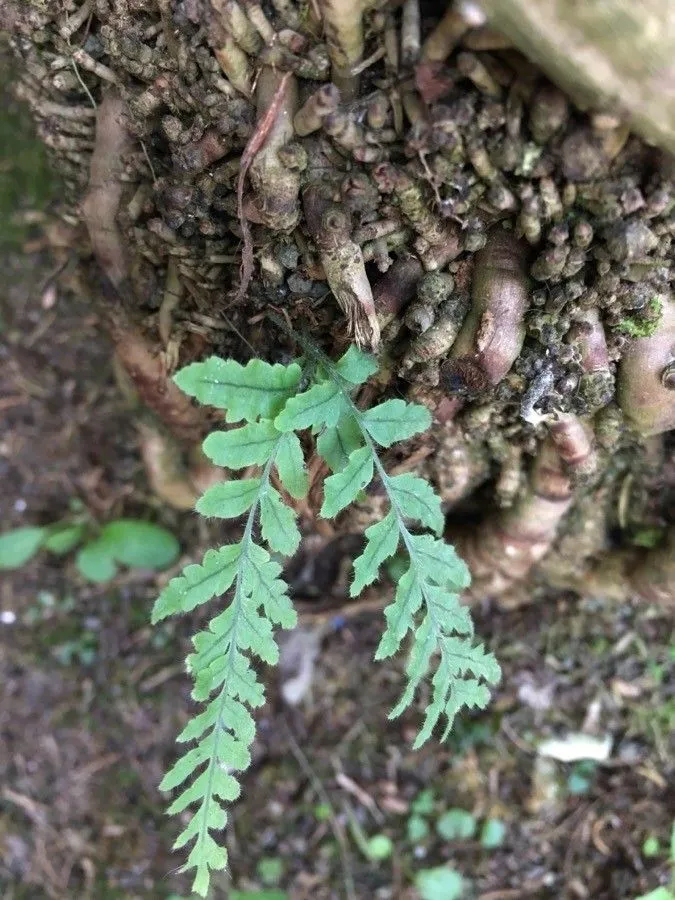
Author: Kaulf.
Bibliography: Enum. Filic.: 102 (1824)
Year: 1824
Status: accepted
Rank: species
Genus: Polypodium
Vegetable: Unknown
Observations: California to N. Mexico, Guadalupe, Revillagigedos Is.
California polypody, with the scientific name Polypodium californicum, is a member of the Polypodiaceae family, which consists of ferns commonly found in diverse habitats. First catalogued by Kaulfuss in 1824, this species has garnered significant attention for its unique characteristics and wide distribution.
California polypody is predominantly found along the western coast of North America, stretching from California through to northern Mexico. Its presence extends to locations such as Guadalupe and the Revillagigedos Islands, showcasing its adaptability to various climates and ecological zones.
The fern is typically seen in moist, shaded environments, often inhabiting coastal woodlands and rocky outcrops. It thrives in these areas, benefiting from the rich organic matter and humidity that these habitats offer. The robust nature of California polypody allows it to form dense, green mats that contribute to the understory biodiversity and help in soil stabilization.
The leaves of Polypodium californicum exhibit a distinctive shape, characterized by their divided fronds that are both visually appealing and evolutionary advantageous for maximizing photosynthesis. Known for their lush green hues and delicate texture, these fronds not only play a crucial role in the fern’s survival but also add aesthetic value to their surroundings.
The reproductive cycle of California polypody follows the typical fern lifecycle, involving spore production rather than seed formation. The spores are produced on the underside of the fronds, in clusters called sori, which are critical for the fern’s propagation. Once mature, these spores are dispersed by wind or water, leading to the growth of new ferns under suitable conditions.
Aside from its ecological role, Polypodium californicum also holds cultural and traditional significance for various indigenous groups. It has been used for medicinal purposes and as a food source, highlighting its importance beyond just its ecological presence.
In summary, California polypody (Polypodium californicum) is a vital species within the Polypodiaceae family, notable for its wide distribution from California to northern Mexico and several islands. Its adaptability, lush fronds, and reproductive strategies underscore its significance within both natural and cultural contexts.
Eng: california polypody
Swe: kalifornisk stensöta
En: California polypody
Ar: سرخس كاليفورني
Sv: Kalifornisk stensöta
Taken Jan 26, 2014 by EOL − c michael hogan (cc-by-nc-sa)
Taken Jan 26, 2014 by EOL − c michael hogan (cc-by-nc-sa)
Taken Apr 17, 2014 by EOL − Cynthia (cc-by-nc)
Taken May 4, 2014 by EOL − Liam O’Brien (cc-by-nc)
Taken Mar 29, 2014 by EOL − Robert Steers (cc-by-nc)
Taken Oct 10, 2020 by Dieter Albrecht (cc-by-sa)
Taken Oct 10, 2020 by Dieter Albrecht (cc-by-sa)
Taken Dec 1, 1998 by EOL − Charles Webber (cc-by-nc-sa)
Taken Feb 15, 2014 by EOL − c michael hogan (cc-by-nc-sa)
Taken Oct 13, 2022 by Ponni Rajagopal (cc-by-sa)
Taken May 8, 2020 by michelle mehan (cc-by-sa)
Taken May 9, 2022 by Thomas Goumarre (cc-by-sa)
Taken Aug 31, 2021 by palandi jadson (cc-by-sa)
© copyright of the Board of Trustees of the Royal Botanic Gardens, Kew.
Taken Feb 13, 2013 by EOL − Thomas Valdriz (cc-by-nc)
Taken Dec 1, 1998 by EOL − Charles Webber (cc-by-nc-sa)
Family: Myrtaceae Author: (F.Muell.) K.D.Hill & L.A.S.Johnson Bibliography: Telopea 6: 402 (1995) Year: 1995 Status:…
Family: Rubiaceae Author: Pierre ex A.Froehner Bibliography: Notizbl. Bot. Gart. Berlin-Dahlem 1: 237 (1897) Year:…
Family: Sapindaceae Author: Koidz. Bibliography: J. Coll. Sci. Imp. Univ. Tokyo 32(1): 38 (1911) Year:…
Family: Asteraceae Author: A.Gray Bibliography: Pacif. Railr. Rep.: 107 (1857) Year: 1857 Status: accepted Rank:…
Family: Fabaceae Author: Medik. Bibliography: Vorles. Churpfälz. Phys.-Ökon. Ges. 2: 398 (1787) Year: 1787 Status:…
Family: Aspleniaceae Author: (Cav.) Alston Bibliography: Bull. Misc. Inform. Kew 1932: 309 (1932) Year: 1932…